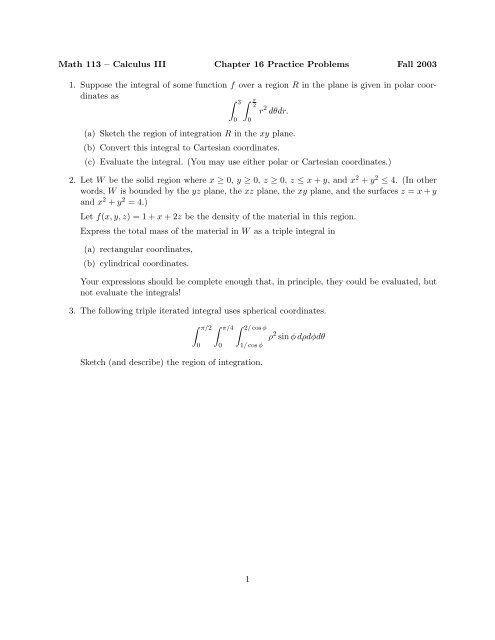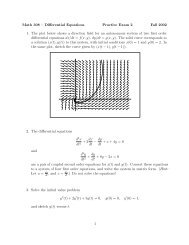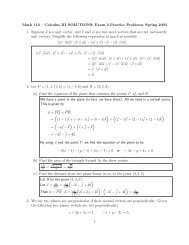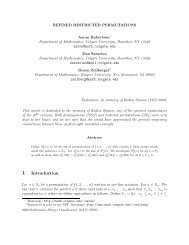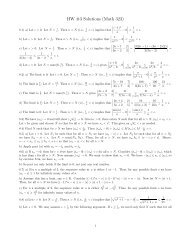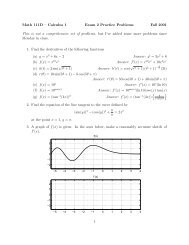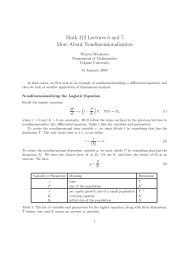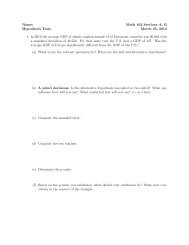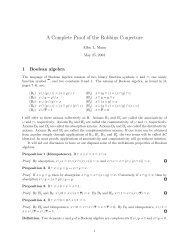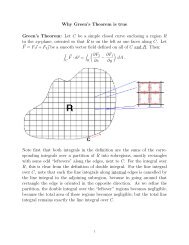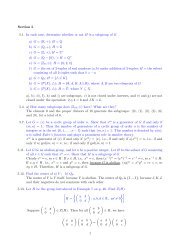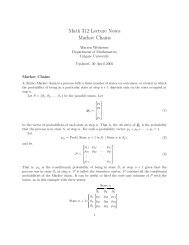Math 113 â Calculus III Chapter 16 Practice Problems Fall 2003 1 ...
Math 113 â Calculus III Chapter 16 Practice Problems Fall 2003 1 ...
Math 113 â Calculus III Chapter 16 Practice Problems Fall 2003 1 ...
You also want an ePaper? Increase the reach of your titles
YUMPU automatically turns print PDFs into web optimized ePapers that Google loves.
<strong>Math</strong> <strong>113</strong> – <strong>Calculus</strong> <strong>III</strong> <strong>Chapter</strong> <strong>16</strong> <strong>Practice</strong> <strong>Problems</strong> <strong>Fall</strong> <strong>2003</strong><br />
1. Suppose the integral of some function f over a region R in the plane is given in polar coordinates<br />
as ∫ 3 ∫ π<br />
2<br />
r 2 dθdr.<br />
(a) Sketch the region of integration R in the xy plane.<br />
(b) Convert this integral to Cartesian coordinates.<br />
0<br />
(c) Evaluate the integral. (You may use either polar or Cartesian coordinates.)<br />
0<br />
2. Let W be the solid region where x ≥ 0, y ≥ 0, z ≥ 0, z ≤ x + y, and x 2 + y 2 ≤ 4. (In other<br />
words, W is bounded by the yz plane, the xz plane, the xy plane, and the surfaces z = x + y<br />
and x 2 + y 2 = 4.)<br />
Let f(x, y, z) = 1 + x + 2z be the density of the material in this region.<br />
Express the total mass of the material in W as a triple integral in<br />
(a) rectangular coordinates,<br />
(b) cylindrical coordinates.<br />
Your expressions should be complete enough that, in principle, they could be evaluated, but<br />
not evaluate the integrals!<br />
3. The following triple iterated integral uses spherical coordinates.<br />
∫ π/2 ∫ π/4 ∫ 2/ cos φ<br />
0<br />
0<br />
1/ cos φ<br />
Sketch (and describe) the region of integration.<br />
ρ 2 sin φ dρdφdθ<br />
1
Brief Solutions<br />
1. (a) Description instead of a sketch: R is the quarter of a disk with radius 3 that is in the<br />
first quadrant.<br />
(b) Remember that in polar coordinates, dA = rdθdr, so one of the “r”s in the integrand<br />
“belongs to” dA. This means that the function f, expressed in polar coordinates, is r<br />
(not r 2 ). Then, in Cartesian coordinates, f is √ x 2 + y 2 . In Cartesian coordinates, the<br />
integral becomes<br />
∫ 3 ∫ √ 9−x 2 √<br />
x 2 + y 2 dy dx.<br />
0<br />
0<br />
(c) 9π 2<br />
2. (a)<br />
(b)<br />
∫ 2 ∫ √ 4−x 2 ∫ x+y<br />
0 0 0<br />
∫ 2 ∫ π/2 ∫ r cos θ+r sin θ<br />
0 0 0<br />
3. (To be provided later.)<br />
(1 + x + 2z) dz dy dx<br />
(1 + r cos θ + 2z)r dz dθ dr<br />
2


